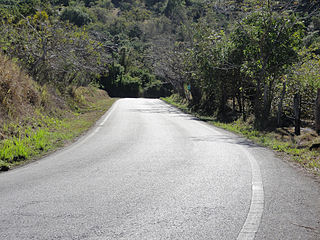
San Lorenzo is a town and municipality of Puerto Rico located in the eastern central region, north of Patillas and Yabucoa; south of Gurabo; east of Caguas and Cayey; and west of Juncos and Las Piedras. San Lorenzo is spread over twelve barrios and San Lorenzo Pueblo. It is part of the San Juan-Caguas-Guaynabo Metropolitan Statistical Area.

Ceiba is both a small town and a municipality in northeast Puerto Rico. It is named after the famous Ceiba tree. Ceiba is located in the north-east coast of the island, bordering the Atlantic Ocean, south of Fajardo, north of Naguabo and southeast of Río Grande. Located about one hour's driving distance from San Juan, Ceiba is spread over 7 barrios and Ceiba Pueblo. It is part of the Fajardo Metropolitan Statistical Area.

Yabucoa is a town and municipality in Puerto Rico located in the eastern region, north of Maunabo; south of San Lorenzo, Las Piedras and Humacao; and east of Patillas. Yabucoa is spread over 9 barrios and Yabucoa Pueblo. It is part of the San Juan-Caguas-Guaynabo Metropolitan Statistical Area.

Comerío is a town and municipality of Puerto Rico in the center-eastern region of island, north of Aibonito; south of Naranjito and Bayamón; east of Barranquitas; and west of Cidra and Aguas Buenas. Comerío is spread over 7 barrios and Comerío Pueblo. It is part of the San Juan-Caguas-Guaynabo Metropolitan Statistical Area.

Guayanilla is a town and municipality of Puerto Rico located on the southern coast of the island, bordering the Caribbean Sea, south of Adjuntas, east of Yauco; and west of Peñuelas and about 12 miles (19 km) west of Ponce. Guayanilla is spread over 16 barrios and Guayanilla Pueblo. It is part of the Yauco Metropolitan Statistical Area.

Hatillo is a town and municipality located in Puerto Rico's north coast, bordered by the Atlantic Ocean to the north, Lares and Utuado to the south, Camuy to the west, and Arecibo to the east. According to the 2000 US Census Hatillo is spread over nine barrios and Hatillo Pueblo. It is part of the San Juan-Caguas-Guaynabo Metropolitan Statistical Area.

Las Marías is a town and municipality of Puerto Rico located north of Maricao; southeast of Añasco; south of San Sebastián; east of Mayagüez; and west of Lares. Las Marías is spread over 13 barrios and Las Marías Pueblo.

Las Piedras, is a town and municipality in east Puerto Rico located in the central eastern region of the island, north of Yabucoa; south of Canóvanas and Río Grande; east of Juncos and San Lorenzo; and west of Naguabo and Humacao. Las Piedras is spread over 7 barrios and Las Piedras Pueblo. It is part of the San Juan-Caguas-Guaynabo Metropolitan Statistical Area.

Luquillo is a town and municipality of Puerto Rico located in the northeast coast, northwest of Fajardo; and east of Rio Grande. Luquillo is spread over 5 barrios and Luquillo Pueblo. It lends its name to the Sierra de Luquillo, where El Yunque National Forest is located. It is part of the Fajardo Metropolitan Statistical Area.

Río Grande is a town and municipality of Puerto Rico located on the eastern edge of the Northern Coastal Valley, north of Las Piedras, Naguabo and Ceiba; east of Loíza and Canóvanas and west of Luquillo. Río Grande is spread over eight barrios and Río Grande Pueblo. It is part of the San Juan-Caguas-Guaynabo Metropolitan Statistical Area. A big portion of El Yunque National Forest, including El Yunque's peak, is located within the municipality.

Canas is one of the 31 barrios in the municipality of Ponce, Puerto Rico. Along with Anón, Coto Laurel, Guaraguao, Quebrada Limón, Real, San Patricio, and Marueño, and the coastal barrio of Capitanejo, Canas is one of the municipality's nine bordering barrios. It borders the municipality of Peñuelas. Along with Playa, Bucana, Vayas and Capitanejo, Canas is also one of Ponce's five coastal barrios. It was founded in 1831.

Quebrada Limón is one of the 31 barrios of the municipality of Ponce, Puerto Rico. Along with Anón, Coto Laurel, Guaraguao, Marueño, Real, and San Patricio, and the coastal barrios of Canas and Capitanejo, Quebrada Limón is one of the municipality's nine bordering barrios. It borders the municipality of Peñuelas. It was founded in 1878.

Tallaboa Alta Barrio is a barrio in the municipality of Peñuelas, Puerto Rico. Its population in 2010 was 3,784.

Macaná is a barrio in the municipality of Peñuelas, Puerto Rico. Its population in 2010 was 803.

Cuebas is a barrio in the municipality of Peñuelas, Puerto Rico. Its population in 2010 was 449.

Encarnación is a barrio in the municipality of Peñuelas, Puerto Rico. Its population in 2010 was 1,378.

Santo Domingo is a barrio in the municipality of Peñuelas, Puerto Rico. Its population in 2010 was 5,761.

Tallaboa Poniente is a barrio in the municipality of Peñuelas, Puerto Rico. Its population in 2010 was 696.

Tallaboa Saliente is a barrio in the municipality of Peñuelas, Puerto Rico. Its population in 2010 was 244.

Peñuelas barrio-pueblo is a barrio and the administrative center (seat) of Peñuelas, a municipality of Puerto Rico. Its population in 2010 was 1,422.

























